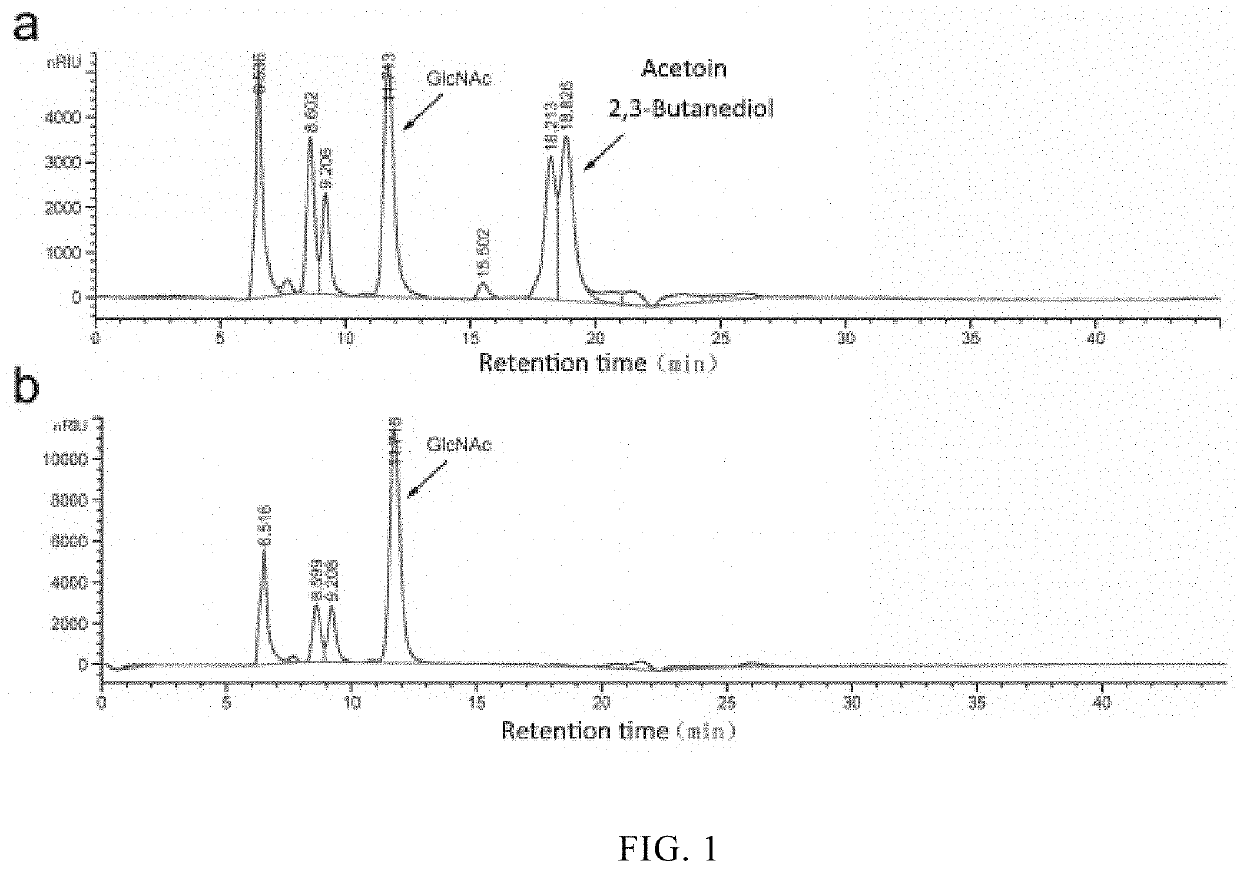Recombinant strain of bacillus subtilis
a bacillus subtilis, recombinant technology, applied in the field of gene engineering, can solve the problems of affecting the maximum theoretical yield (yc) of the n-, affecting the synthesis of by-product acetoin, and affecting the synthesis of acetoin, etc., to achieve the effect of eliminating the synthesis of by-product acetoin, promoting acetylglucosamine synthesis, and central
- Summary
- Abstract
- Description
- Claims
- Application Information
AI Technical Summary
Benefits of technology
Problems solved by technology
Method used
Image
Examples
embodiment 1
[0045]Construction of Bacillus subtilis BSGNKAP3
[0046]The Bacillus subtilis BSGNKAP2 was B. subtilis 168ΔnagPΔgamPΔgamAΔnagA4nagBΔldhΔptaΔglcK ΔpckA Δpyk P43-glmS P43-pycA::lox72, and GNA1 gene was freely expressed by using pP43NMK-GNA1 plasmid. The specific construction method can be referred to the disclosure of Patent Application CN 201610517961.9. Then, based on this, the pyruvate carboxylase BalpycA encoding gene balpycA (NCBI-Protein ID: AAS42897) derived from Bacillus cereus was integrated into malS locus in Bacillus subtilis BSGNKAP2 genome. Upstream sequence (SEQ ID No. 1, 1000 bp) of the integration malS locus, zeocin resistant gene zeo sequence, strong constitutive promoter P43, target gene sequence balpycA and downstream sequence (SEQ ID No. 2, 1000 bp) of malS locus were used for constructing an integration cassette. The integration cassettes obtained were integrated into the Bacillus subtilis BSGNKAP2 genome by homologous recombination. By screening through zeocin resi...
embodiment 2
[0047]Construction of Bacillus subtilis BSGNKAP4
[0048]Bacillus subtilis BSGNKAP3 was used as the host, and GNA1 gene was freely expressed by using pP43NMK-GNA1 plasmid. The glyceraldehyde-3-phosphate ferredoxin dehydrogenase encoding gene gor (NCBI-ProteinID: CAF30501) was integrated into pyk locus in Bacillus subtilis BSGNKAP3 genome. Upstream sequence (SEQ ID No. 3, 1000 bp) of the integration pyk locus, zeocin resistant gene zeo sequence, strong constitutive promoter P43, target gene sequence gor and downstream sequence (SEQ ID No. 4, 1000 bp) of pyk locus were used for constructing an integration cassette. The obtained integration cassette was integrated into the Bacillus subtilis BSGNKAP3 genome by homologous recombination. By screening through zeocin resistance flat plates, carrying out colony PCR verification and sequencing, it was confirmed that integration was successful and the recombinant Bacillus subtilis BSGNKAP4 was obtained.
embodiment 3
[0049]Construction of Recombinant Bacillus subtilis BSGNKAP5
[0050]BSGNKAP4 was used as the host, and GNA1 gene was freely expressed by using pP43NMK-GNA1 plasmid. The isocitrate NAD+ dehydrogenase encoding gene icd (NCBI-Protein ID: AKC61181) was integrated into ywkA locus in Bacillus subtilis BSGNKAP4 genome. Upstream sequence (SEQ ID No. 5, 1000 bp) of the integration ywkA locus, zeocin resistant gene zeo sequence, strong constitutive promoter P43, target gene sequence icd and downstream sequence (SEQ ID No. 6, 1000 bp) of ywkA locus were used for constructing an integration cassette. The obtained integration cassette was integrated into the Bacillus subtilis BSGNKAP4 genome by homologous recombination. By screening through zeocin resistance flat plates, carrying out colony PCR verification and sequencing, it was confirmed that integration was successful and the recombinant Bacillus subtilis BSGNKAP5 was obtained.
PUM
| Property | Measurement | Unit |
|---|---|---|
| Strain point | aaaaa | aaaaa |
Abstract
Description
Claims
Application Information
 Login to View More
Login to View More - R&D
- Intellectual Property
- Life Sciences
- Materials
- Tech Scout
- Unparalleled Data Quality
- Higher Quality Content
- 60% Fewer Hallucinations
Browse by: Latest US Patents, China's latest patents, Technical Efficacy Thesaurus, Application Domain, Technology Topic, Popular Technical Reports.
© 2025 PatSnap. All rights reserved.Legal|Privacy policy|Modern Slavery Act Transparency Statement|Sitemap|About US| Contact US: help@patsnap.com


